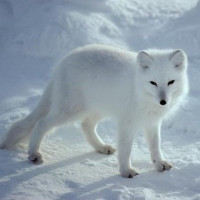 |
Arctic fox |
|
He is a wild animal |
Origin |
Arctic | |
Translation |
Francis Vandersteen | |
This breed is also known as |
Isatis
|
| The possession of this animal is not authorized Royal Decree establishing the list of mammals not kept for production purposes that may be kept (M.B. 24.08.2009) |
| Arctic fox or Isatis or Blue fox, of the Canidae family, is a fox native to the Arctic regions that includes at least four subspecies and was farmed for its fur between the wars. The polar fox lives in environments where temperatures are very low in winter. It can withstand temperatures of -50°C. This hardy animal has few predators. Today, polar foxes are found throughout the Arctic, in Greenland, Russia, Canada, Alaska, Svalbard, Iceland and the Scandinavian Alps. With the exception of Scandinavia, the conservation status of the Arctic fox in the IUCN is good (Least Concern). The arctic fox is the only mammal native to Iceland. It arrived on this isolated North Atlantic island at the end of the last ice age, walking on the frozen sea. The number of polar foxes tends to vary in a cycle corresponding to the population of lemmings, one of their main prey. On the other hand, as foxes reproduce very rapidly and often die young, they are not very sensitive to the effects of hunting. However, they have been exterminated in several areas where humans have settled. The polar fox is losing ground to the larger red fox. Historically, the gray wolf has kept the red fox population fairly low. The extermination of the gray wolf in many regions has enabled the red fox population to grow, and the latter has taken over the large predator's niche. In some parts of northern Europe, hunting programs allow red foxes to be hunted in areas where polar foxes once lived. Smaller than its cousin the red fox, it measures between 50 centimetres and 1 metre and weighs around 5 kilos. Its ears are smaller than those of the red fox, and its muzzle is shorter. Its fur helps limit heat loss, a vital asset given its polar environment. In winter, its white fur helps it blend into the snowy landscape of its habitat. In summer, its coat is dark brown. He uses his long tail to cover his muzzle and paws when he sleeps. Its life expectancy in the wild is ten to fifteen years. It feeds mainly on small animals, such as lemmings or polar hares, and birds and their eggs. It also feeds on seal and reindeer carcasses left by polar bears and wolves. Polar foxes breed from early September to early May. They form monogamous pairs during this period. Gestation lasts 52 days. Litters average 6 to 7 cubs, but can reach as many as 11. The male and female help raise the cubs in a foxhole. The females then leave the family to form their own groups, while the males remain with the family. |






 English (United Kingdom)
English (United Kingdom)